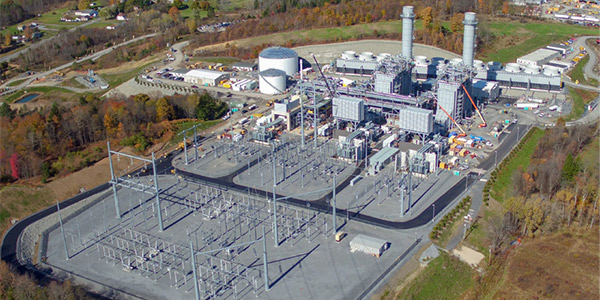By Michael Yoder
The Marcellus Shale formation has turned Pennsylvania into the nation’s No. 2 natural gas producer and made it a favorite spot for new gas-fired electric generation. Natural gas’s share of the state’s electric production more than doubled to 36% from 2010 to 2018.
But there is something different about the state’s newest generating plant. If natural gas prices rise from their current low prices, Competitive Power Ventures’ 1,050-MW Fairview Energy Center near Johnstown can add up to 25% ethane into its fuel mix — the first generation facility of its size in the world with that kind of flexibility, according to CPV.
Located on an 86-acre former brownfield site in Jackson Township, Cambria County, the General Electric-designed combined cycle plant successfully completed ethane testing in March and went into full combined operation this month.
Bill Lawson, senior engineer for new products at GE Gas Power, said customers have been seeking the ability to burn an array of gases to respond to fluctuating commodity prices. Lawson said GE began looking several years ago at shale gas and its byproducts, including ethane, that could serve in power generation.
“GE saw this trend developing early and focused technology development to broaden our fuel flexibility,” Lawson said.
Price Trends
Ethane, commonly referred to as a natural gas liquid, is a hydrocarbon that can be found underground in shale and coal beds. In addition to being burned as a fuel, ethane also is used to produce ethylene, a chemical used in the manufacturing of plastics, automotive antifreeze and detergent.
According to the Energy Information Administration, ethane prices tracked crude oil spot prices until 2008 but began to diverge as U.S. production growth from shale gas and tight oil formations overwhelmed ethane consumption by the domestic petrochemical industry. By 2012, ethane prices closely tracked natural gas prices, staying within $1/MMBtu of the Henry Hub natural gas spot price on a heating-value-equivalent basis.
Since late 2017, EIA says, ethane demand has been growing because of increased petrochemical use and ethane export capacity. “As a result, ethane prices began to move away from their link to natural gas prices, and they are now bracketed by propane at the top and natural gas at the bottom of the range,” EIA said.
Ethane spot prices fell 17% from January to March this year — while natural gas prices dropped 11% and international crude oil fell about 46% — because of the economic slowdown from the COVID-19 pandemic.
Nearby Pipelines, Transmission
Natural gas for Fairview comes from the Enbridge Texas Eastern Transmission gas lines, about 1 mile north of the plant site. The ethane comes from Mariner East pipelines located on site. The plant also is adjacent to a 500-kV circuit that delivers its output to PJM, enough for 1 million homes and businesses.
CPV, which has ownership interests in 4.2 GW of generation in the U.S, partnered with Osaka Gas on the plant.
Jeff Ahrens, vice president of engineering and construction for CPV and the director of the $1 billion project, said the company wanted to incorporate ethane from an early stage in the plant’s development. While CPV had experience with the equipment and engineering needed for natural gas generators, adding ethane presented new challenges.
“It’s the first of its kind on this scale, so it required a lot of patience to make sure we did it right, make sure everything was designed correctly and look at all the different scenarios that the system needed to have to be reliable and safe for us,” Ahrens said. “Every step was somewhat new.”
Fairview was Ahrens’ second project for CPV, following the St. Charles Energy Center, a 745-MW combined cycle plant in Waldorf, Md., that went into operation in 2017.
Ahrens said one of the biggest challenges was that ethane comes to the plant in liquid form and requires vaporization to mix with the natural gas.
Natural gas is more buoyant than ethane, Ahrens said, so designs had to be created to find the right way to mix the two. The result was a GE vaporizer as large as a truck to mix the two fuels.
Fairview took nearly three years of development before construction began, requiring a team of hundreds of GE and CPV engineers, manufacturers, logistics exports and transportation workers.
“It required a lot of research, understanding [and] getting the right team members together who either had some experience or knew people who had experience, like petrochemical guys in the oil and gas industries,” Ahrens said.




